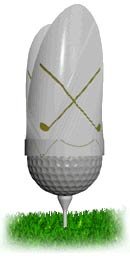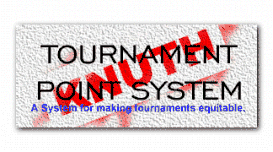



|
Letter to USGA
January 18, 2001
Dear Reed,
I know that you will be considering an important issue affecting the USGA Handicap System at the upcoming Handicap Committee meeting in New York City. I recently wrote to Kevin O'Connor with my point of view and I also would like to share my thoughts with you prior to that meeting.
Based on my more than twenty years in working with the USGA Handicap System -- sixteen of them on staff--, I urge you to leave the decision on electronic measuring equipment as it stands--Allowing scores to be posted when they are used.
Furthermore, I urge the USGA to further separate the Rules of Golf from its Handicap System by easing your interpretation of the words "principles of the Rules of Golf" that already exist in the USGA Handicap System Manual. This change to the Handicap System was architected by Judy Bell and M.J. Mastalir, with my full support in the fall Executive Committee meeting of 1993. It was a smart way to handle such inconsistencies that you are struggling with. There are no legal reasons to keep Rules and Handicapping combined to the point that Rules interpretations have an exclusionary impact on golfers that maintain a USGA Handicap Index. All that is required is that golf clubs follow the Handicap System and that peer review is provided. I recommend that you use the "play by the principles of the Rules of Golf" terminology as broadly as you can in the Handicap System to embrace all golfers and I urge you to avoid using the Rules of Golf as a hammer within its Handicap System.
As an example, in the 1980's the Handicap Committee put an age limit on scores (two years) which suddenly took away USGA Handicaps from inactive golfers. At the time, we thought that it would make Handicaps more accurate. It turned out to be a bad move which impacted on many golfers and it also impacted financially on all regional and state golf associations. We quickly dropped the age limit under the principle that "any score is better than no score" in determining a player's Handicap. I think that the same principle applies to scores using electronic measurement devices, or when using non-conforming clubs--Any score is better than no score. I think that decisions to exclude golfers from their handicaps will once again give the USGA a PR problem--especially from the casual golfers constituting the vast majority of players. Pushing these Rules versus Handicapping issues also will once again cause a negative impact on the revenues of regional golf associations.
The golf club conformance issue is an important part of this same issue, and it happens to be at the crux of the current issue above. I am in favor of the USGA developing procedures for reporting scores any way you can, every time you play. That was the basis for reporting and combining nine-hole scores in the past decade. Your current direction is, instead, leading to many ways to avoid posting scores. Furthermore, eliminating golfers from having a USGA Handicap based on what equipment he uses is philosophically wrong from my standpoint and could eventually affect more than a million golfers. All - in - all, the argument in favor of posting scores for all rounds is a good one and the rush of technology could make this all a hard problem for the USGA to manage. Furthermore, you should be aware that in San Diego county, at the very least (and probably elsewhere), I know personally of golfers that are having good results with the new non-conforming clubs and their country clubs or the professional staff and fellow golfers are telling these golfers to post their scores because they want their handicaps to reflect their current play. The USGA decision has not had the impact that it intended in many cases, nor will it be applied uniformly around the country. This is another reason to stay away from an exclusionary position.
Should the USGA decide not to go back on its decision on not posting scores made with non-conforming drivers, are you aware that your current ruling provides a huge loophole in handicapping? A golfer can buy a non-conforming driver and practice his game and improve his game, but never have to post a score to his USGA Handicap Index. So, let's say that his game has improved by several strokes over time--due mostly to his practice. Now he enters a tournament based on his latest 20 "postable" scores which are months old. He can enter the tournament using his conforming driver, and play better than his handicap. It is the type of problem that comes from tying the Rules of Golf equipment decisions strictly to the USGA Handicap System.
While I am on the subject of non-conforming drivers, please allow me to share with you my other thoughts on this conflict with the USGA Handicap System:
As you are aware, drivers with the "spring-like effect" have been declared to be conforming to the Rules of Golf outside of the United States and Mexico by the Royal and Ancient Golf Club. Being a member of the R&A, I read their ruling on spring-like effect. It concluded with this statement: " It has been determined that modern driving clubs have greater clubhead flexibility or higher COR values than wooden and first generation metal drivers. However, based on the data currently available to the R&A, any consequential increase in driving distance that may be achieved and which is solely attributable to these factors, is not considered to be detrimental to the game. The R&A is also satisfied that any further increases in clubhead flexibility and COR values, which may be evident in the next generation of driving clubs will not, by themselves, significantly increase driving distance. It is also felt that the equipment being used is only one of the factors which enables modern golfers to hit the ball further than their predecessors." It is well known that the USGA made a different interpretation. However, this R&A conclusion makes the USGA's position on not posting in handicapping much weaker with the golfing public, in my opinion.
You probably know the history, but prior to 1993, the USGA Handicap System procedure had required that a round had to be played strictly under the Rules of Golf to be posted. This position of strict adherence caused a great deal of consternation within the USGA�s Handicap Committee and with me, as their Senior Director of Handicapping. We wanted all the latest available scoring information to be included in a player�s USGA Handicap Index, which is based on the best 10 of a player�s last 20 rounds and we had to wink a lot with the inconsistency in the real world. Any realist would quickly recognize that for many, if not most American golfers, they would not have many valid scores to post under this strict interpretation. Many golfers either knowingly, or unknowingly, violate the Rules of Golf every time that they play golf. A few examples: The use of mulligans, or carrying more than 14 clubs, using someone else�s club from his bag, removing a leaf from a bunker, incorrect drops, grounding your club in a bunker, or improperly taking relief, using a putting ball on greens, or here�s a big one�using winter rules when they are not in effect. How about golfers that move their ball off of sand divots in the fairway, hitting a provisional ball without declaring that ball to be provisional. Not to mention that there are more than one thousand Rules Decisions, and only a small percentage of experts are aware of all of them. Yet, despite all these common infractions, golfers post their scores for USGA Handicap purposes and they are playing by the principles of the Rules of Golf--or, so they think.
The issue of strict Rules compliance came to a head in 1993 when the USGA ruled that the then popular white plastic hole liners that went up to the surface of the green (used to improve visibility of the hole) were a violation of the Rules. Thousands of golf courses were using them at the time. The USGA Handicap Committee wisely ruled that scores should still be posted because players on those courses were playing under the "principle" of the Rules of Golf, despite the fact that they were not playing the course under the Rules of Golf. The wording "principles" was added to the next edition of the USGA Handicap System manual, which was a great relief to me and the Handicap Committee, because it set right the long-term position that all postable scores needed to be posted. The Handicap System works best when more scores are entered�rather than fewer. From that point onward, there were a number of definitions and decisions issued that covered all sorts of common situations. For example, the Rules of Golf Committee declared that the use of electronic distance finders were a violation of the Rules, but were under the "principle" of the Rules (Do post). I always had trouble with the fact that distances measured by surveying instruments could be placed on every sprinkler head, as well as yardage markers in the fairways and anywhere else, but to use your own measuring device which could give a person faster measurements were a violation of the Rules. Other decisions: If you take a mulligan on a hole, you must post a score of par plus handicap strokes for that hole, no matter how you played it after the mulligan. If you play a majority of holes under the Rules of Golf, post your score, but otherwise you don�t�And if you play thirteen or more holes, post an 18-hole score by putting "net par" down for the holes that you didn�t play. If you pick-up on a hole, put down your most likely score that you would have made had you finished the hole�not to exceed your Equitable Stroke Control (ESC) limit. Combine your nine hole scores and post them as an 18-hole score.---All these makes for a lot of mis-interpretations and questions. But, I was part of this process and I admit that the goal was to figure out equitable ways to get scores posted and ways to prevent people from having an excuse not to post the round. As you also can see, all of these procedures are violations of the Rules of Golf, but all of these are ways to get all scores posted for the USGA Handicap System.
I don�t have a non-conforming driver, but if I did, I suppose that I would use it 14 times out of about 90 shots. Most of those 14 shots depend on my erratic swing, since there isn�t a club that will do the swinging for me. Based on Course Rating statistics, my score won�t average more than a stroke better per round. The handicap variables that effect my scores by more than a stroke are: the WEATHER, WIND, COURSE CONDITIONS, FREQUENCY OF PRACTICE, AND FREQUENCY OF PLAY. Yet, every one of those scores under every condition is posted, which makes what driver I use rather inconsequential.
Besides the scoring variables, there are errors in the present USGA Handicap System which impact more on the scores that are posted than the effect of a non-conforming driver. The biggest is the current ESC system. It works well for the single digit handicapper, who has a score maximum of double bogey. But it doesn�t work as well for the masses because for the 10 to 19 handicapper, his limit is 7 on all holes�A 7 on a par 3 and a 7 on a par 5. Meaning, there is no ESC on par 3�s and too tight of a limit on par 5�s. The same goes for those in the 20 to a 29 handicap range, where the limit is 8 on any hole. I submit that more errors come from the ESC limits than the effect of a non-conforming driver. Yet, from my position on the Handicap Research Team, I don't believe that you are currently researching any improvements to the ESC system. More importantly, many golfers don�t post all of their scores. Under a strict interpretation of the USGA Handicap System, if a golfer has not posted all of his scores in their last 20 rounds, their handicap is not valid.
The purpose of a handicap system is to equitably measure your scoring ability with the scoring ability of other golfers, no matter what equipment you are using. If one golfer can afford a set of expensive irons and it helps his game, then that golfer will develop a lower handicap relative to another golfer that is playing with K-mart clubs. If someone�s game does measurably improve by using a non-conforming driver, his handicap will go down. If I am playing in a handicap tournament with those players, I could care less, from a Handicap standpoint�provided their Handicap Index was developed using that driver.
I devoted 20 years of my life to improving the USGA Handicap System through developing an equitable Course Rating System, teaching it world-wide, reducing the portability problem with the Slope Rating System that I developed and from years of attacking the sandbagger issue. After all, these are the most important issues in handicapping. Judy Bell and I also promoted the formation of golf clubs "without real estate" nation-wide and helped millions of golfers get USGA Handicaps. I hate to see any decisions that put recreational golfers into a position that takes USGA Handicaps away from them through a strict interpretation of the Rules of Golf. The USGA should instead devote more attention to including more golfers in its System. Having rules is great, but they should not be used as a hammer in its Handicap System.
The game of golf is so difficult to master, anything that comes along that helps non-expert golfers (99 percent of us) play better adds enjoyment to their game and I call that a good thing that poses no threat to the game. Personally, I am approaching my mid-fifties and I would love to get back some of the distance that I have lost in the past ten years. If it lowers my handicap by a few tenths of a stroke�so what? Let�s not have a USGA decision hurt anyone that wants to make their mediocre game a little less mediocre. I should still be able to have a USGA Handicap, should I decide to use a little better driver. To me, I get more thrill from watching my drive go far than any other part of my game. Whether my score would go down is debatable, as I still have to get the ball onto the green and into the hole.
I think that you should broaden your interpretation of "principles" of the Rules of Golf in the Handicap System. Accept almost all scores. Don't exclude scores based on I&B decisions. Also, realize that most golfers don�t know the Rules very well and violate them regularly, but they still think that they are playing golf. Under strict interpretation, most golfer�s USGA Handicaps aren�t valid anyway. I think that posting scores from rounds using a non-conforming driver, is just another variable to add to the mix, and they should be just fine. You also should take note that you are putting the golf professionals of this country into a very difficult position. They are going to sell the drivers that are demanded by their club members. These are the same golf professionals that are going to be asked to make sure that their buyers don�t post their scores. The current USGA interpretation will alienate many of America�s recreational golfers and the issue will likely only get more acute as the popularity of "hot" drivers grows.
I plan to attend the USGA Annual Meeting and I would look forward to discussing this with you in person, if you have the time.
Good luck at your meetings.
Best regards,
Dean Knuth
Copy: Trey Holland, David Fay, Kevin O'Connor, Judy Bell
|










